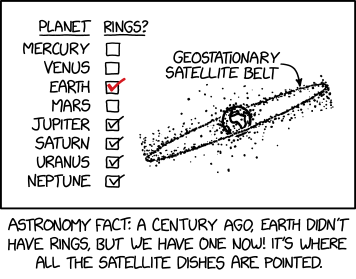this post was submitted on 17 Oct 2025
527 points (99.4% liked)
xkcd
13595 readers
113 users here now
A community for a webcomic of romance, sarcasm, math, and language.
founded 2 years ago
MODERATORS
you are viewing a single comment's thread
view the rest of the comments
view the rest of the comments

Making an educated guess as a layperson, besides some satellites that are geosynchronous but not geostationary, I'd assume those are primarily old geostationary satellites in graveyard orbits - when they're EOL, satellites in those orbits are supposed to perform a small boost out of them, usually adding a few hundred km to their orbit's radius (GEO is about 36,000km in altitude, so a few hundred km is relatively small). Then, without station keeping, I believe they should naturally precess around the Laplace plane, which will range between roughly Earth's equator and the ecliptic plane (the plane of Earth's orbit). At GEO altitudes the Laplace plane is about 7.2 degrees inclined from the equator. I believe that would mean, starting at the equator with an inclination of 0 degrees, these satellites should precess to about 14.4 degrees and back to 0 over several decades (excluding other perturbations, of course).
I found this online which would seem to confirm at least the mechanics: https://amostech.com/TechnicalPapers/2013/Orbital_Debris/ROSENGREN.pdf